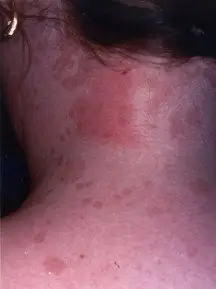What is Tinea Versicolor?

Many microorganisms normally live on our skin, including a group of yeast species called Malassezia. (Round or oval yeasts in this group were previously known by the names Pityrosporum orbiculare and Pityrosporum ovalis.) The yeast lives in our pores. Under certain conditions, it can shift its form from a round or oval yeast shape to a string-like, branching shape. These branching forms are named hyphae. The yeast can migrate under the skin and produce azelaic acid, a substance that can change the amount of pigment (color) in new skin cells. In its hyphae form, the yeast causes a rash called tinea versicolor, also called pityriasis versicolor.
Tinea versicolor is common year-round in the tropics and subtropics and is seen in the summer months in more temperate climates. Sun exposure, use of oils on the skin, naturally oily skin and sweating are all suspected to be triggers that can cause the round or oval yeast to convert to its hyphae form, resulting in the rash.
Tinea versicolor occurs more often in teenagers and young adults and appears on the back, neck, upper chest, shoulders, armpits and upper arms. Most people who get this rash are in good health. However, tinea versicolor is more likely to occur if you have a suppressed immune system, for instance, if you are taking a corticosteroid medication such as prednisone for another health problem. It is also more common in women who are taking birth control pills and in pregnant women.
Symptoms
The skin rash is made up of scattered pink, tan, brown or white patches on the skin. Each person will usually have only one of the colors. These patches are usually flat, without texture, but may flake. They may be small round spots or areas that start smaller then get larger and combine with other areas. The rash may be itchy, especially when a person is hot or sweaty.
|
|
The skin spots may be more obvious after skin has been exposed to the sun, because these areas do not tan evenly.
Diagnosis
Your doctor can examine skin scrapings under the microscope to see if the yeast is present. Your doctor may also shine a black light (ultraviolet light) on the rash to help confirm the diagnosis. Yeast types in the Malassezia group may glow yellow-green under the light.
Expected Duration
Your doctor can examine skin scrapings under the microscope to see if the yeast is present. Your doctor may also shine a black light (ultraviolet light) on the rash to help confirm the diagnosis. Yeast types in the Malassezia group may glow yellow-green under the light.
Prevention
Because the rash occurs more readily in hot, humid conditions, keep your skin as dry and cool as possible when you are in this climate.
The tinea versicolor rash continues to return in 40 percent to 60 percent of people. If you have had more than one episode of tinea versicolor, skin treatment every two weeks with a shampoo that destroys yeast (such as anti-dandruff shampoos that contain selenium sulfide) can help to prevent the rash from recurring. This may be especially helpful prior to travel to a tropical climate or during months with warm weather. Another option is to take antifungal medicines by mouth to prevent the rash from returning.
Treatment
Topical treatment should be tried first in most cases. Therapies include lotions or anti-dandruff shampoos containing selenium sulfide (Selsun), zinc pyrithione, ketoconazole shampoo (Nizoral), terbinafine spray (Lamisil) and antifungal creams. Topical treatments are used one or two times each day. Treatment can last days or weeks, depending on how the rash responds.
Short courses of oral medications, such as itraconazole [Sporanox] or fluconazole [Diflucan]), are also effective. The oral medications are usually reserved for people with a widespread rash and those who have failed topical therapy.
For six months after your original treatment, you may be advised to apply topical treatments occasionally or take one or more doses per month of oral antifungal medicine to help prevent the rash from returning.
Treatment options
The following list of medications are in some way related to or used in the treatment of this condition.
- ketoconazole
- Diflucan
- Nizoral
- Oxistat
- Sporanox
View more treatment options
When To Call a Professional
If you have a skin rash that you think may be tinea versicolor, you should make an appointment with your doctor to have the rash evaluated.
Prognosis
There are no serious complications from tinea versicolor. In most people, the rash goes away with treatment. However, it takes several months for the skin to return to its normal appearance. The rash can return after treatment in some people who don't use antifungal treatments from time to time to suppress the rash.
Additional Info
American Academy of Dermatology
http://www.aad.org/





